
A steamship, often referred to as a steamer, is a type of steam-powered vessel, typically ocean-faring and seaworthy, that is propelled by one or more steam engines that typically move (turn) propellers or paddlewheels. The first steamships came into practical usage during the early 1800s; however, there were exceptions that came before. Steamships usually use the prefix designations of "PS" for paddle steamer or "SS" for screw steamer. As paddle steamers became less common, "SS" is assumed by many to stand for "steamship". Ships powered by internal combustion engines use a prefix such as "MV" for motor vessel, so it is not correct to use "SS" for most modern vessels.

Her Danish Majesty's Yacht Dannebrog (A540) was launched by Queen Alexandrine at Copenhagen in 1931, and commissioned on 26 May 1932. The yacht now serves as the official and private residence for Queen Margrethe II of Denmark, and members of the Royal Family when they are on official visits overseas and on summer cruises in Danish waters. When at sea, the Royal Yacht also participates in surveillance and sea-rescue services.
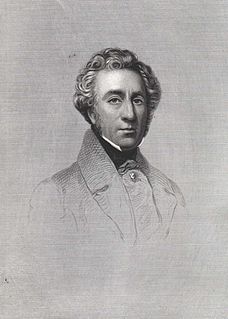
Robert Napier was a Scottish marine engineer known for his contributions to Clyde shipbuilding.

Andreas Frederik Krieger was a Danish politician, government minister, professor of law and supreme court judge. He was a member of the National Constitutional Assembly from 1848 to 1849, a member of the Folketing from 1849 to 1852 representing the National Liberal Party and a member of the Landsting from 1863 to 1890 representing first the National Liberal Party and later the conservative party Højre.
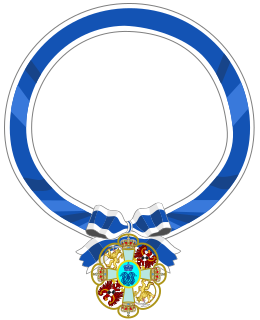
The Ordre de l'Union Parfaite was created by Queen consort Sophie Magdalene of Denmark and Norway on 7 August 1732 to celebrate the tenth anniversary of her happy marriage with King Christian VI of Denmark and Norway. It was given to both men and women. Its motto was In felicissimæ Unionis Memoriam.
William Patterson Shipbuilders was a major shipbuilder in Bristol, England during the 19th century and an innovator in ship construction, producing both the SS Great Western and SS Great Britain, fine lined yachts and a small number of warships.

The General Steam Navigation Company (GSNC), incorporated in 1824, was London's foremost short sea shipping line for almost 150 years. It was the oldest shipping company in the world to begin business with seagoing steam vessels.
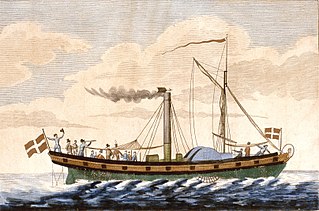
Caledonia was a paddle-wheel steamer, built in Scotland in 1815. The ship was bought by a Danish businessman in 1819 and it became the first steamship registered in Denmark. It spent most of its active years in Denmark operating between the cities of Copenhagen and Kiel. Broken up around 1843.
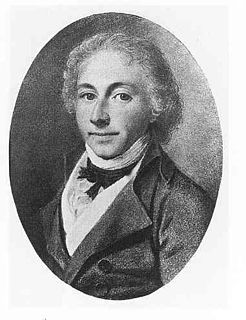
Frantz Christopher Henrik Hohlenberg was a Danish naval officer who specialised in ship design and had little seagoing experience.
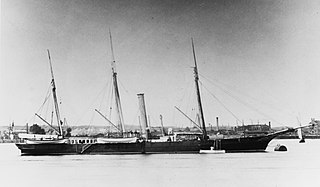
SMS Grille was an aviso of the Prussian Navy built in France in the mid-1850s as part of a naval expansion program directed by Prince Adalbert of Prussia, who saw the need for a stronger fleet. She was authorized in 1855 in the aftermath of the First Schleswig War, which had demonstrated the weakness of the Prussian fleet. Grille was the first screw propeller-driven steamship to be built for Prussia; all earlier steam-powered vessels had been paddle steamers.

Andreas Schifter (1779–1852) was a Danish naval officer and shipbuilder, a capable naval administrator and admiral. He oversaw the transition of the Danish navy from sail to early steam power.

Kingston was a paddle-wheel steamer, built in England in 1821. The ship was bought by Danish owners in 1824 and became the first steamship on the route between Copenhagen and Lübeck. In Denmark her name was changed to Prindsesse Wilhelmine, in honour of Princess Vilhelmine Marie of Denmark, youngest daughter of king Frederick VI. In 1844 the ship became a three masted schooner and it was broken up around 1877.

Dandy was a paddle-wheel steamer, built in England in 1823. The ship was bought in 1825 by a Danish businessman and employed on the route between Copenhagen and Aarhus with the new name Jylland. The small steamer was not well suited for the job and in 1826 it was sent to Altona in Hamburg, where it got the name Dandy back and sailed between towns on the Elbe river. It was still present in the ship list from Altona in 1843, but by 1845 it was gone.

Tordenskjold was a steam frigate of the Royal Danish Navy. The ship was named after Peter Tordenskjold, a 16th-century Danish admiral.

Quentin Durward was a paddle-wheel steamer, built in the United Kingdom in 1823. The ship was bought in 1827 by a Danish businessman and was employed on a route between Copenhagen and ports in Jutland and Funen, with the name Dania. She later served on the route between Aarhus and Kalundborg. The paddle-wheeler was broken up in 1841.

Mercurius was a paddle-wheel steamer, built in the United Kingdom in 1828. The ship was ordered by the Royal Danish Mail Service in Copenhagen and was employed on the postal and passenger service on the Great Belt between Korsør and Nyborg. In 1856 she was sold to Joseph Owen & Sønner in Copenhagen and in 1864 she was acquired by Oscar Petersen with the name Robert. Removed from the ship list in 1867.

Frederik den Sjette was a paddle-wheel steamer, built in 1830 for the merchant Lauritz Nicolai Hvidt of Copenhagen. She was the first steamship to be built in Denmark, with the notable exception of the steam engine, which was delivered from England. The vessel replaced the Caledonia on the route between Copenhagen and Kiel, and she had other routes as well. Sold in 1845 and foundered later that year. The ship was named in honour of the ruling king of Denmark and was also referred to as Frederik den Siette, Frederik VI and Frederik 6.
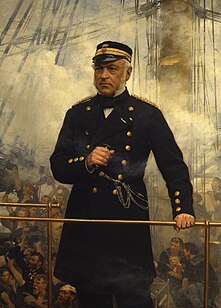
Edouard Suenson was a Danish vice admiral who was known for his participation in the First Schleswig War and Second Schleswig War where he was the main Danish commander at the Battle of Heligoland.





















